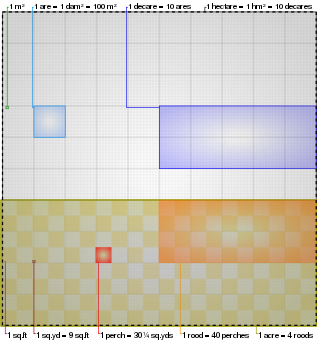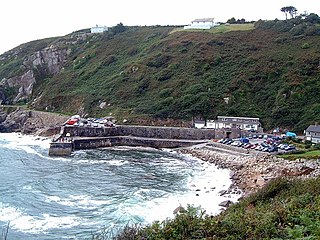
The acre is a unit of land area used in the imperial and US customary systems. It is traditionally defined as the area of one chain by one furlong, which is exactly equal to 10 square chains, 1⁄640 of a square mile, 4,840 square yards, or 43,560 square feet, and approximately 4,047 m2, or about 40% of a hectare. Based upon the international yard and pound agreement of 1959, an acre may be declared as exactly 4,046.8564224 square metres. The acre is sometimes abbreviated ac but is usually spelled out as the word "acre".

A furlong is a measure of distance in imperial units and United States customary units equal to one eighth of a mile, equivalent to 660 feet, 220 yards, 40 rods, 10 chains or approximately 201 metres. It is now mostly confined to use in horse racing, where in many countries it is the standard measurement of race lengths, and agriculture, where is it used to measure rural field lengths and distances.

Lamorna is a village, valley and cove in west Cornwall, England, UK. It is on the Penwith peninsula approximately 4 miles (6 km) south of Penzance. Lamorna became popular with the artists of the Newlyn School, including Alfred Munnings, Laura Knight and Harold Knight, and is also known for former residents Derek and Jean Tangye who farmed land and wrote "The Minack Chronicles".
The rod, perch, or pole is a surveyor's tool and unit of length of various historical definitions, often between approximately 3 and 8 meters. In modern US customary units it is defined as 16+1⁄2 US survey feet, equal to exactly 1⁄320 of a surveyor's mile, or a quarter of a surveyor's chain, and is approximately 5.0292 meters. The rod is useful as a unit of length because whole number multiples of it can form one acre of square measure (area). The 'perfect acre' is a rectangular area of 43,560 square feet, bounded by sides 660 feet long and 66 feet wide or, equivalently, 40 rods and 4 rods. An acre is therefore 160 square rods or 10 square chains.

Antony is a coastal civil parish and a village in Cornwall, England, United Kingdom.
The chain is a unit of length equal to 66 feet. It is subdivided into 100 links or 4 rods. There are 10 chains in a furlong, and 80 chains in one statute mile. In metric terms, it is 20.1168 m long. By extension, chainage is the distance along a curved or straight survey line from a fixed commencing point, as given by an odometer.

Richard Carew was a British translator and antiquary. He is best known for his county history, Survey of Cornwall (1602).

Gunter's chain is a distance measuring device used for surveying. It was designed and introduced in 1620 by English clergyman and mathematician Edmund Gunter (1581–1626). It enabled plots of land to be accurately surveyed and plotted, for legal and commercial purposes.
English units are the units of measurement used in England up to 1826, which evolved as a combination of the Anglo-Saxon and Roman systems of units. Various standards have applied to English units at different times, in different places, and for different applications.

Crackington Haven is a coastal village in Cornwall, England, United Kingdom. It is in the civil parish of St Gennys at grid reference SX140972 at the head of a cove on the Atlantic coast. The village is seven miles (11 km) south-southwest of Bude and four miles (7 km) north-northeast of Boscastle.

Scottish or Scots units of measurement are the weights and measures peculiar to Scotland which were nominally replaced by English units in 1685 but continued to be used in unofficial contexts until at least the late 18th century. The system was based on the ell (length), stone (mass), and boll and firlot (volume). This official system coexisted with local variants, especially for the measurement of land area.
A marla is a unit of area used in the Indian subcontinent.

Ruan Lanihorne is a civil parish and village in south Cornwall, England, United Kingdom. The village is situated approximately four miles (6.5 km) east-southeast of Truro between the River Fal and its tributary the Ruan River.
There are a number of Spanish units of measurement of length or area that are virtually obsolete due to metrication. They include the vara, the cordel, the league and the labour. The units of area used to express the area of land are still encountered in some transactions in land today.

Week St Mary is a village and civil parish in northeast Cornwall, England, United Kingdom. It is situated south of Bude close to the River Tamar and the border between Cornwall and Devon in the Hundred of Stratton. The parish population at the 2011 census is 657.

The River Cober is a short river in west Cornwall, England, United Kingdom. The river runs to the west of Helston into The Loe, Cornwall's largest natural lake.
The following are the basic measurements of land used in the Punjab region, divided between Indian and Pakistani Punjab and many parts of North India and Pakistan in ascending order.
A rood is a historic English and international inch-pound measure of area, as well as an archaic English measure of length.

The Western Rocks are a group of uninhabited skerries and rocks in the south–western part of the Isles of Scilly, United Kingdom, and are renowned for the numerous shipwrecks in the area and the nearby Bishop Rock lighthouse. In 1971, the rocks and islands were designated a Site of Special Scientific Interest for their breeding sea birds. Landing on the islands is both difficult and discouraged and there are few published records of visits by naturalists.

Perran Round is an amphitheatre in the hamlet of Rose, midway between the villages of Goonhavern and Perranporth, Cornwall, UK. It is described as the best surviving example of a plen-an-gwary, a medieval amphitheatre used for performing the Ordinalia, or Cornish miracle plays.












